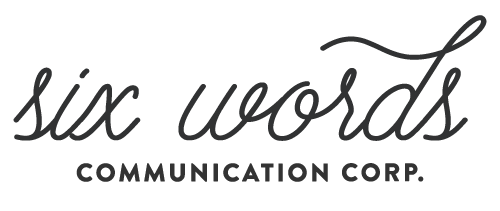
The Value of a Content Calendar
By Team Six Words
When managing marketing and communications for your small business or non-profit, it can be hard to keep track of important dates, events, milestones and trends. Then throw in a variety of platforms – from social media, video channels and blogs, to newsletters and beyond – and it’s likely your head is spinning!
The good news is, with a bit of work and planning, you can set yourself up to successfully manage your content strategy. How? With a strategic content calendar.
Here are six reasons why a content calendar is good for business:
Add Structure – Gathering important dates and content milestones in one place will help you organize the content you need to prepare and share. At Six Words, we typically develop annual overviews alongside detailed quarterly calendars to help us stay on top of our content goals and keep an eye on the future. This approach helps us add structure and avoid always having to ask “what’s next?”.
Save Time – When you take time to plan out your content calendar in advance, you don’t have to scrounge each week for new ideas. You already know what you should be focused on. And, with a clear path forward, we also find it easier to adapt and pivot when new content needs arise. Surprises or new priorities are easier to manage on a strong foundation.
Never Forget Important Dates – It happens to all of us… forgetting to post content on an important date in the midst of a busy week is never fun. With a content calendar, everything you need to remember is already laid out for you.
Create Better Original Content – Instead of rushing to get something up, your content calendar will help you develop better, strategic content that resonates with your audience. With a sightline into what’s coming, you can create quality and targeted original content ahead of time.
Get a Birds Eye View – A content calendar, like most strategic plans, lets you take a high level view of what’s happening and what’s coming up. This way, you’ll be able to plan campaigns and strategies that maximize your communications and marketing efforts.
Accurately Measure Your Success – Content calendars also let you compare and contrast content day to day, week to week, month to month and eventually year to year. By keeping track of what you publish and how it performs, you’ll be able to better identity what works and what doesn’t.
While every content calendar may look a bit different based on your needs, goals and preferred format, each content calendar should have some key elements:
- A regular ol’ calendar view option so you can see what you are publishing, and when
- A way to colour code or organize different types of content (are you posting a video, image or text?)
- A way to view different communication platforms (what content is being posted where?)
- A way to capture or note key dates that you want to communicate around (and why)
- A way to capture performance metrics
With these elements in mind, it’s up to you to decide how you want to pull it all together. You can build a custom spreadsheet in excel (this guide is helpful), download an online template (we like this one and this one), or explore a content calendar app (check out this or this).
Need help creating your own content calendar? Ask us.

